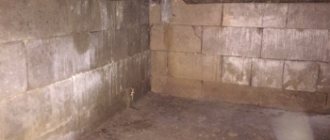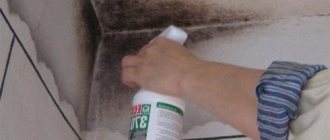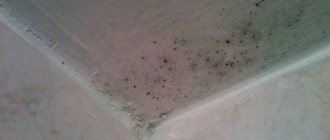Why does mold form under the floor and in the underground of a wooden house?
Fungus appears under the floor for a reason. Causes:
- The temperature difference between an uninsulated and/or unheated basement and living spaces causes condensation to accumulate and cause excessive dampness. And mold develops in a humid environment.
- Poor ventilation. In the musty, still air the fungus feels very at ease.
- Lack of antiseptic treatment of the materials from which the subfloor is built. Wooden parts of the structure are especially susceptible to mold and rot.
- The fungus can spread to the walls and floor of the basement from the products stored there if they are affected by it.
Fungus
Harm and damage from fungus formation
When mold “comes” into your home and settles on the walls or floor of your home, it entails many different problems. The first is, of course, the appearance of the room. Everything is covered with green and white fluff and dark spots. It seems to me that the sight is not the most pleasant.
That is why it is very important to detect the appearance of mold in time and begin work to remove it as soon as possible, since the problem will grow in scale every day.
This is due to the fact that if the fungus has begun to develop, then the spores that make up it begin to develop very quickly, as a result of which gray moss can envelop your house in a fairly short time.
The second reason why getting rid of fungus must take place immediately is because it causes harm to the human body. The thing is that spores flying in the air enter the human body when he breathes near foci of fungus. As a result, a person may become ill with not the most pleasant diseases. In addition, the volatile substances that are released by the source of formation also have a not very pleasant odor. In general, living in such a wooden house is not the most pleasant pleasure.
And the last reason is the variety of forms of fungus. Simply put, if you wait too long to remove mold from your home, it can eventually adapt to the environment and can survive even in low temperatures, both zero and sub-zero temperatures.
Harm from mold to property and human health
Visible mold under the floor of a wooden house can be the initial stage of a fungal infection. However, wooden floors, ceilings, and walls are destroyed very quickly under the influence of fungus. One day, not a wonderful day, the house may simply collapse.
Attention! Mold spores are microscopic in size and fly long distances. In a short time, under favorable conditions, a large area can be infected with the fungus.
The fungus causes diseases that are dangerous to humans, pets and indoor plants. Possible exacerbation of chronic ailments, development of allergies, rheumatoid and heart diseases, diseases of the respiratory system, up to the development of bronchial asthma.
How to destroy fungus step by step
So, having chosen a mold control tactic, the following steps are taken:
- Existing mold must be removed. To do this, you can use soapy water and sandpaper.
- Treat the surface with an antifungal agent.
- Inspect all items, and if mold is found, clean them too. If you can’t clean it (the mold has settled deeply and reliably), then it’s better to throw the thing away.
- The main weapon that will work for the future “future without mold” is to establish good ventilation; you need to organize a constant flow of fresh air.
- Reduce humidity in the basement.
How to get rid of mold under the floor and in the underground of a private house?
The basement, cellar, and space under the floor of a wooden house most often suffer from the effects of harmful fungus.
How to get rid of mold on boards and joists?
When mold and rot are discovered under a wooden floor, the question of how to remove them is very pressing. If the boards are rotten by more than half, they should be replaced with new ones.
If the fungus is visible only on the surface, then:
- the top, contaminated layer must be removed with a scraper or a stiff metal brush;
- soak the boards generously with an antiseptic solution or the same copper sulfate, leave for several hours;
- whiten twice with Bordeaux mixture.
Treatment
Anti-mold agents and their use
There are quite a lot of means that can be used to treat a cellar.
- One of the most common tips on how to get rid of fungus in the underground of a wooden house is with the help of such a folk remedy as copper sulfate. 100 g of powder is diluted in a bucket of clean hot water. The solution is applied with a wide brush or roller to the walls, floor, and ceiling of the basement, and allowed to soak in. The treatment is repeated after a month.
- Lime is a long-known, well-proven folk remedy. 500 g of lime are stirred in 10 liters of water. To enhance the effect, you can add 200 g of formaldehyde. The liquid is applied with a roller or brush to shelves, floors, and walls. You can use a spray gun.
- Chlorine is an effective substance for getting rid of mold in the crawl space. Dilute chlorine bleach, “Whiteness” with water, the solution should be concentrated. First, mechanically remove the mold deposits, then generously moisten the surfaces with bleach.
Attention! Chlorine vapors are very toxic to humans and animals. Observe personal protective measures and wear a respirator. Ventilate the room thoroughly.
- A combustible sulfur bomb will get rid of any type of mold, as well as moss, which can also appear in a damp cellar. It is better to place the checker in a metal basin or tray, set it on fire and quickly leave the basement. After 12 hours, the cellar is opened, ventilated and dried.
Attention! To achieve the effect when using a sulfur bomb, ventilation pipes, windows, and cracks in the basement must be closed.
- Also among the folk methods can be noted treatment with solutions of vinegar, boric or citric acid, table salt, ammonia, and tea tree oil. However, they are labor-intensive and less effective compared to the above.
- A modern method of combating any pathogenic microorganisms is treatment with high temperatures using a microwave apparatus. The advantage of this method is that it is safe for people and pets, but is carried out only by specialized organizations.
Waterproofing, treatment and wall covering
It is impossible to remove mold from the underground of a wooden house without waterproofing the foundation. The process is labor-intensive, but necessary:
- The base of the cellar is exposed and cleaned.
- Then the cleaned foundation is waterproofed. Different materials can be used:
- polymer membrane;
- bitumen mastic;
- roofing felt;
- ready-made coating mixtures, etc.
- Drainage pipes are laid.
- Lay geotextiles.
- The last stage is backfilling and pouring the blind area.
Ventilation
It is impossible to solve the question of how to get rid of mold fungi in the cellar without a device for high-quality ventilation of the room. The fight will not be successful if you do not provide dry air in the underground of the house. The easiest way to arrange supply and exhaust ventilation is to install two pipes of the same diameter in opposite corners of the basement.
Ventilation
- The first pipe - the supply pipe - is mounted half a meter from the floor level in the basement. The top end is above the foundation.
- The exhaust hood is placed in the upper corner of the cellar, and rises 0.5 m above the ridge. It should be insulated (for example, with mineral wool) to prevent the accumulation of condensation.
- The outer ends of the pipes are covered with canopies.
Attention! The pipe material can be any: PVC, reinforced concrete, metal, plastic.
How to fill the underground from dampness?
To get rid of fungus and prevent its appearance in the basement or subfloor of a wooden house, follow a simple technology.
- The first step is to get rid of the top layer of soil in the underground. You should remove about 20 cm to remove all the overgrown mold mycelium.
- Next, you can spill the soil with a solution of copper sulfate for disinfection, let it soak in, then pour a layer of lime (1-2 cm).
- The next layer is geotextile.
- A cushion of sand and crushed stone is placed on it.
- Lay the next layer of dense impermeable film or roofing felt.
- You can install logs and lay a wooden floor.
Alternatively, you can fill the crawl space floor with moisture-absorbing expanded clay.
Types of fungi
Before I start telling you about how to properly remove mold from the walls of your home, it is necessary to say that there are only two types of fungus.
- The first is wood staining;
- The second is wood destroying.
As for the first case, I can please you - the fight against this species is more than real, and the chances of defeating the disease are quite high. Wood staining fungus usually settles on the very surface of the wood, and it takes quite a long time for it to penetrate into the pores. This means that the disease lasts long enough, and you have every chance to save the walls or floor of your house without any special consequences.
As for the second case, with such a disease, mold very quickly affects the tree, and therefore it must be eliminated as soon as possible. If you do not have time to do this, then most likely you will have to demolish the building or replace elements that were susceptible to destruction by fungus. Therefore, I repeat once again, measures to remove fungus from the walls must be applied as soon as you discover the problem, otherwise it will be too late.
Prevention measures
After the fungus in the cellar is destroyed, care must be taken to ensure that it does not reappear. Preventive measures will help with this.
- Insulate the building and install waterproofing.
- Make it a rule to regularly inspect rooms where excess dampness may appear, paying special attention to corners, joints and places where sunlight does not penetrate or is extremely rare.
- Ventilate the basement, avoid dampness.
- Treat all surfaces, both wooden and other materials, with a fungicidal antiseptic.
If you are in the process of construction, listen to the advice and take care in advance to prevent fungus from settling in the house.
- A ventilation device will avoid problems with dampness. If it is impossible to design a supply and exhaust system, at least make windows for ventilation. It would be good if sunlight would also penetrate through them.
- Insulate the foundation and waterproof the basement and subfloor.
- Building materials should be treated with an antiseptic.
- It would be good if heating was provided in the basement.
Reasons for appearance
Mold is quite common in the basement. The fungus affects vegetables stored in the cellar, boxes and boxes in which food is stored, wooden floors, doors, as well as the walls and ceiling of the room. There can be several reasons for the appearance of mold in the cellar.
Ventilation
When the air in the cellar circulates poorly due to lack of ventilation, especially in the case of stagnant air masses, the most favorable conditions are created for the growth and development of mold. This situation can arise if the ventilation system is not provided, is not properly equipped, or is clogged.
Humidity
Ventilation problems also cause increased humidity in the cellar, which can be avoided if the room is regularly and thoroughly ventilated. When moisture accumulates, condensation forms, in which case mold will almost certainly appear.
Spoiled products
The fungus has the ability to spread quickly. If products contaminated with spores are placed in the cellar for storage, they will easily spread to other supplies stored in the basement, the walls and ceiling of the room. In the presence of a favorable environment, mold brought on the surface of rotten products will grow at high speed throughout the cellar.
Infested wood products
No less quickly, a fungus that has infected wooden boxes or other containers in which vegetables or root crops were brought will spread over the surfaces of the cellar. Increased humidity and heat in the room promote the growth and development of mold.











